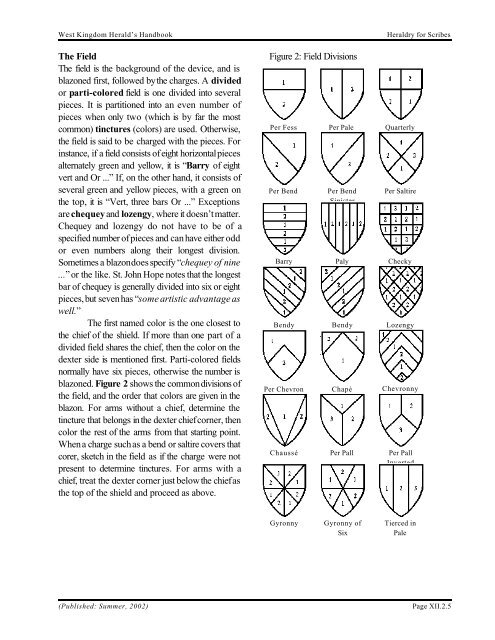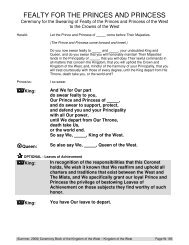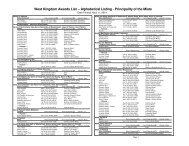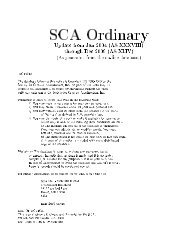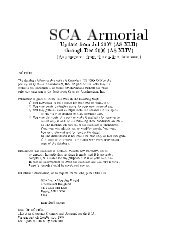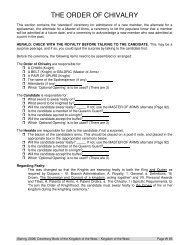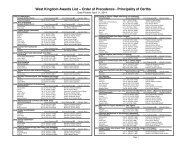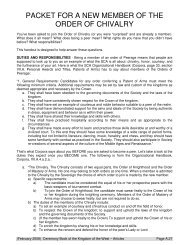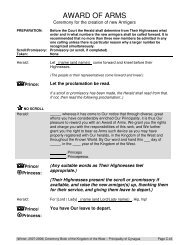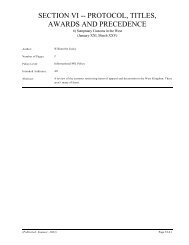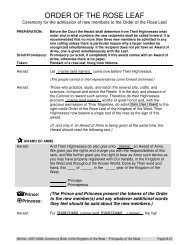Heraldry For Scribes Part 2 - West Kingdom College of Heralds
Heraldry For Scribes Part 2 - West Kingdom College of Heralds
Heraldry For Scribes Part 2 - West Kingdom College of Heralds
You also want an ePaper? Increase the reach of your titles
YUMPU automatically turns print PDFs into web optimized ePapers that Google loves.
<strong>West</strong> <strong>Kingdom</strong> Herald’s Handbook<br />
The Field<br />
The field is the background <strong>of</strong> the device, and is<br />
blazoned first, followed by the charges. A divided<br />
or parti-colored field is one divided into several<br />
pieces. It is partitioned into an even number <strong>of</strong><br />
pieces when only two (which is by far the most<br />
common) tinctures (colors) are used. Otherwise,<br />
the field is said to be charged with the pieces. <strong>For</strong><br />
instance, if a field consists <strong>of</strong> eight horizontal pieces<br />
alternately green and yellow, it is “Barry <strong>of</strong> eight<br />
vert and Or ...” If, on the other hand, it consists <strong>of</strong><br />
several green and yellow pieces, with a green on<br />
the top, it is “Vert, three bars Or ...” Exceptions<br />
are chequey and lozengy, where it doesn’t matter.<br />
Chequey and lozengy do not have to be <strong>of</strong> a<br />
specified number <strong>of</strong> pieces and can have either odd<br />
or even numbers along their longest division.<br />
Sometimes a blazon does specify “chequey <strong>of</strong> nine<br />
...” or the like. St. John Hope notes that the longest<br />
bar <strong>of</strong> chequey is generally divided into six or eight<br />
pieces, but seven has “some artistic advantage as<br />
well.”<br />
The first named color is the one closest to<br />
the chief <strong>of</strong> the shield. If more than one part <strong>of</strong> a<br />
divided field shares the chief, then the color on the<br />
dexter side is mentioned first. <strong>Part</strong>i-colored fields<br />
normally have six pieces, otherwise the number is<br />
blazoned. Figure 2 shows the common divisions <strong>of</strong><br />
the field, and the order that colors are given in the<br />
blazon. <strong>For</strong> arms without a chief, determine the<br />
tincture that belongs in the dexter chief corner, then<br />
color the rest <strong>of</strong> the arms from that starting point.<br />
When a charge such as a bend or saltire covers that<br />
corer, sketch in the field as if the charge were not<br />
present to determine tinctures. <strong>For</strong> arms with a<br />
chief, treat the dexter corner just below the chief as<br />
the top <strong>of</strong> the shield and proceed as above.<br />
Figure 2: Field Divisions<br />
Per Fess<br />
Per Bend<br />
Barry<br />
Bendy<br />
Per Chevron<br />
Chaussé<br />
Per Pale<br />
Per Bend<br />
Sinister<br />
Paly<br />
Bendy<br />
Sinister<br />
Chapé<br />
Per Pall<br />
<strong>Heraldry</strong> for <strong>Scribes</strong><br />
Quarterly<br />
Per Saltire<br />
Checky<br />
Lozengy<br />
Chevronny<br />
Per Pall<br />
Inverted<br />
Gyronny<br />
Gyronny <strong>of</strong><br />
Six<br />
Tierced in<br />
Pale<br />
(Published: Summer, 2002)<br />
Page XII.2.5
<strong>Heraldry</strong> for <strong>Scribes</strong><br />
Figure 3: Lines <strong>of</strong> <strong>Part</strong>ition<br />
Urdy<br />
Invected<br />
Engrailed<br />
Indented<br />
<strong>West</strong> <strong>Kingdom</strong> Herald’s Handbook<br />
The lines <strong>of</strong> partition need not be just straight lines: if they are not,<br />
they should be bold enough to be identifiable from a distance. Thus,<br />
three to five copies <strong>of</strong> the basic unit <strong>of</strong> the design placed across the<br />
width <strong>of</strong> the shield is about right. Figure 3 gives their names and<br />
pictures. Lines <strong>of</strong> partition not only apply to divisions <strong>of</strong> the field, but<br />
they can be applied to the ordinaries and subordinaries.<br />
Since a line <strong>of</strong> partition cannot face “outward” the rule is that ti faces<br />
in the more “honorable” position: chief over base, dexter over<br />
sinister. Thus, a field per pale invected would have points to dexter,<br />
the arches to sinister. This appears to be the mundane practice,<br />
though precedent is somewhat muddled. Society practice is exactly<br />
the same. “Per pale” is the same in both but “per fess engrailed”<br />
mundanely would probably have the points to base (because the<br />
chief position “owns” the partition line), and Society practice places<br />
the points to chief so they look like the cups the partition line is<br />
named for.<br />
Raguly<br />
Embattled<br />
Diapering<br />
Diapering means to fill the blank spaces on a shield with a pattern<br />
<strong>of</strong> lines in a slightly darker or lighter hue <strong>of</strong> the same tincture. It is<br />
not mentioned in the blazon and is purely at the artists’ discretion.<br />
Uncharged otherwise empty fields or ordinaries were commonly<br />
diapered in period scrolls.<br />
Dovetailed<br />
Potenty<br />
Nebuly<br />
Wavy<br />
Diapering<br />
<strong>of</strong> the Arms <strong>of</strong><br />
De Warrenne<br />
An example <strong>of</strong> diapering<br />
both field and charge. In<br />
this case a fess.<br />
Rayonny<br />
Lines <strong>of</strong> <strong>Part</strong>ition<br />
Page XII.2.6 (Published: Summer, 2002)
<strong>West</strong> <strong>Kingdom</strong> Herald’s Handbook<br />
Tinctures are divided into color, metal, fur, and<br />
proper, and are used according to the Rule <strong>of</strong><br />
Tincture:<br />
Thou shalt<br />
not<br />
place<br />
metal upon<br />
metal<br />
nor<br />
color upon<br />
color.<br />
Tables 2 and 3 list colors and metals with<br />
recommended paints. Furs and proper are<br />
nominally neutral with respect to this rule, as long as<br />
contrast is maintained.<br />
Note: On period scrolls, silver metal as pigment is<br />
not <strong>of</strong>ten used, due to tarnishing and chemical<br />
reaction, its use is not in general recommended. --<br />
Ed.<br />
Table 2: Colors<br />
<strong>Heraldry</strong> for <strong>Scribes</strong><br />
Name: Sable<br />
Color: Black<br />
Shade: Greyish Black<br />
Paint: Ivory black & dab white or india ink<br />
Name:<br />
Color:<br />
Shade:<br />
Paint:<br />
Name:<br />
Color:<br />
Shade:<br />
Paint:<br />
Name:<br />
Color:<br />
Shade:<br />
Paint:<br />
Name:<br />
Color:<br />
Shade:<br />
Paint:<br />
Name:<br />
Color:<br />
Paint:<br />
Color:<br />
Paint:<br />
Name:<br />
Color:<br />
Paint:<br />
Color:<br />
Paint:<br />
Azure<br />
Blue<br />
Bright aquarmarine<br />
Ultramarine & Cerulean<br />
Gules<br />
Red<br />
Vermilion<br />
Vermilion or cadmium red light<br />
Vert<br />
Green<br />
Emerald green<br />
Emerald; or azure & cadmium yellow<br />
light.<br />
Purpure<br />
Purple<br />
Mauve<br />
Purple lake, or azure & cadmium red<br />
light.<br />
Table 3: Metals<br />
Or<br />
Gold<br />
Grumbacher designer color cake;<br />
gold ink; decoupage “gold” foil;<br />
genuine gold leaf; genuine shell<br />
gold<br />
OR<br />
Yellow<br />
Pale yellow ochre; cadmium yellow<br />
light.<br />
Argent<br />
White<br />
Chinese white<br />
OR<br />
Silver<br />
Silver ink; decoupage ‘silver’ foil.<br />
(Published: Summer, 2002)<br />
Page XII.2.7


